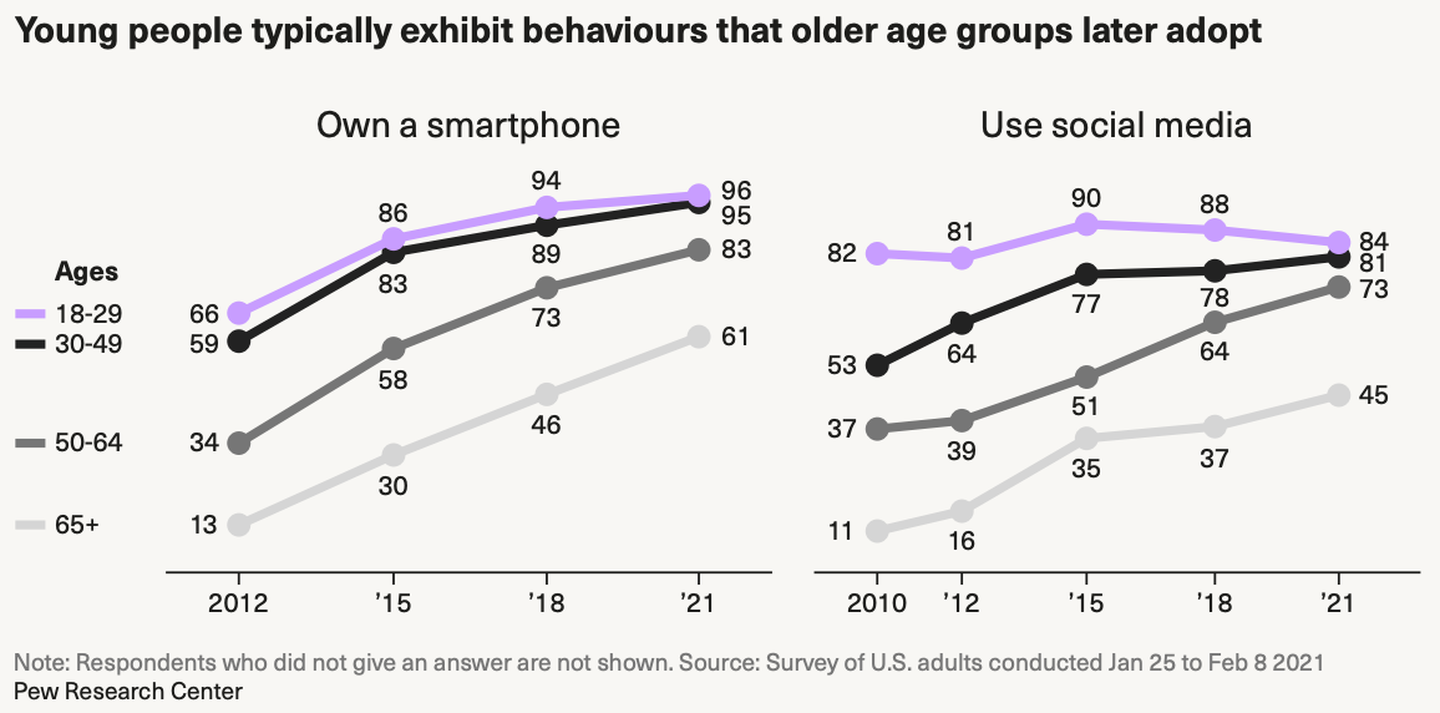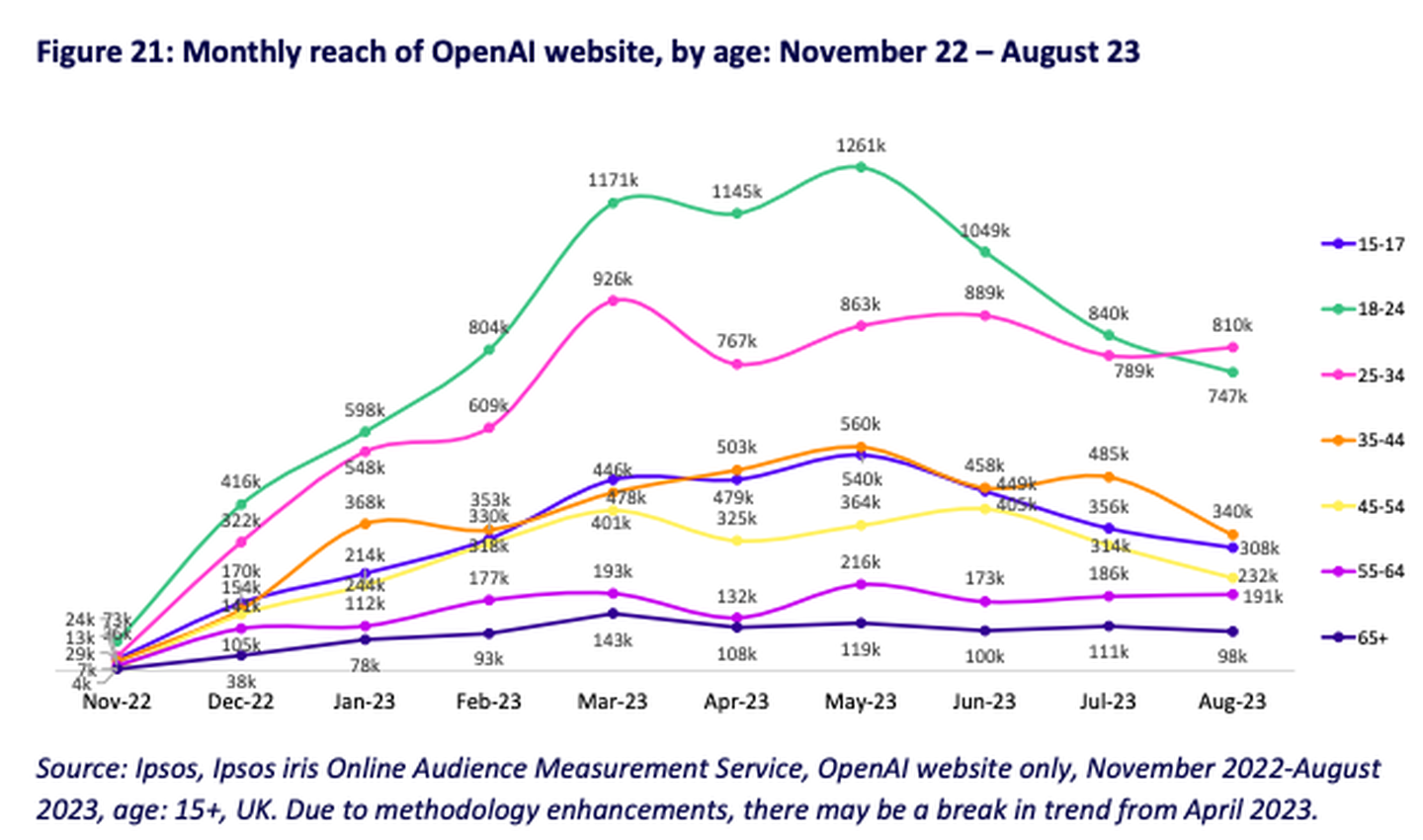FT Strategies has published its latest research, Next Gen News, conducted in partnership with the Medill School of Journalism at Northwestern University, and supported by the Google News Initiative. You can watch the recording of the launch event here.
The research focuses on understanding the needs of the younger audiences of today so that news publishers can be better prepared to serve the audiences of tomorrow. This premise, that the behaviours and needs of the next generation of consumers anticipate the eventual behaviours of most news consumers in the future, was core to our research. And it's already happening with the newest technology on the block: generative AI.
One graph we kept on coming back to was this one below from the Pew Research Center. It shows that young people are often the bellwethers for broader shifts in society, whether that is technological (owning a smartphone) or content consumption (usage of social media). This mirrors the shift we have seen in news consumption - away from TV/Print/proprietary websites to intermediaries like social platforms, search and, to a lesser extent, aggregators - that the Reuters report has tracked over the years.





Well, you’ve guessed it… the same is occurring with generative AI. Look no further to research done by Ofcom in the UK in late 2023 about who is visiting and using ChatGPT the most. 18-24 and 25-34-year olds leapfrog in terms of consumption, while other age groups steadily increase over time. Not only, but Ofcom also highlights how “Four in five (79%) online teenagers and two in five (40%) online 7-12s had used any of the following generative AI tools: ChatGPT, Snapchat My AI, Midjourney or DALL-E. Half of UK online 7-17-year olds said in June 2023 that they had used Snapchat My AI, making it the most popular generative AI tool among children.”





These considerations are not just about wider content, but also about news. We find that there is a gap between what younger audiences want from the news and what is being provided by news producers.
Our research found that the next generation has a complex and evolving relationship with the news. They simultaneously understand the value it can play in their lives but are often disinterested or frustrated with how it's being delivered to them. Specifically in terms of their desired storytelling experience, they often want to feel more in control of the format they consume, want the ability to query themselves to understand the context of information, and look for simpler language and tone.
To talk about some of these opportunities and how AI can help enhance the distribution or creation of trusted journalism, we hosted a panel at the Next Gen News launch event to talk, amongst other things, about generative AI. Acknowledging the ethical challenges of the technology, the panel focused rather on the opportunities for news creators (big or small) in using gen-AI tools for themselves.
Below you can find part of the panel discussion, highlighting three key points:
- How generative AI can enable the creation of new formats through text-to-speech or text-to-video tools
- How generative AI can help change the language or tone of news content in order to adapt it to different audiences, including ‘translation-at-scale’
- How generative AI can help news creators in the news-gathering process by for example sifting through large government documents or datasets
Our panel included a variety of experts that are either news producers who are specifically finding success in reaching younger audiences and/or have a deep knowledge of media and technology trends. Namely:
- Jeremy Gilbert: Knight Professor in Digital Media Strategy, Medill School of Journalism
- Monika Plaha: BBC Presenter and Journalist
- Ruona Meyer: Researcher, Trainer, and former Investigative Journalist of the Year in Nigeria
- Jack Kelly: Founder and Content Creator at TLDR News
Question: Is there one example that you each have on how you are using Generative AI in a way that is actually enhancing the distribution and creation of trusted journalism especially to reach the next generation of consumers?
Ruona Meyer: One thing I use personally, and I know a lot of us freelancers use it, is murf.ai (text-to-speech and text-to-video AI voice generator). It is paid-for so might not be useful for everyone but I think it’s worth the money.
What it does is that I can record something on the field in one language, and then I throw it into Murf and it will give me a voiceover. Then I can choose the age of that voice, so that it’s something that younger people prefer or feel represented by. Another way is I can write up a piece and have Murf help me spit out an audio version to appeal to different format preferences.
I can make the voice older as well. For example, in Senegal I spoke to someone from Yoruba, and we spoke in this urban French language, but I was publishing in Germany. Since the audience is actually older, I chose the voice of an older German woman. Within a minute though I could choose from a lot of different versions: an older German female, a young English male, an old English male, etc. Murf can then help you also with turning these into videos and go beyond the traditional news format.
Monika Plaha: I use Generative AI mainly on my personal TikTok pages and the videos I create there. There’s loads that the app helps me with, for example adding the transcript or caption automatically, because as we all know, for TikTok videos to do well you need the text to give people full context, but it also makes it bold and striking to get the user's attention.
On a voice aspect as well it's very helpful. If for any reason I can’t do the voiceover myself, I can just use their AI voiceover function which is so easy and it sounds amazing. It can adapt to a man or a woman, or a younger voice which is very helpful. It can also be very helpful for translation as I do a lot of content on South Asian history and it can be translated to Punjabi which makes it so that I don’t have to worry about my level.
Jeremy Gilbert: The Knight Lab does a lot of work with prototyping tools for journalists or news consumers, and what I am taking away from this whole work is we often don’t spend enough time thinking about whether the audience at an individual level know themselves all the context of news, which is different to simply just using generative AI to create stories that ultimately look very much like the ones that we create today.
What we are trying to experiment with is how we can understand where the audience is in terms of their individual background and knowledge of news at a given point, and how we can connect them to the stories they need to know today to stay on top of the news agenda.
So, to get practical. We built a tool that looks at running coverage of a story of a news publisher. So if a publisher published 10 stories in the last week on a particular topic, we can use first-party data to say “this user has read these 2 or 3 stories out of the 10” and then we can summarise each of the ones they have not read, and we can tell them what background information they need to know to engage with today’s story.
If the goal is to say, “Let’s get everyone to the same place”, it's perfectly acceptable to give everyone a slightly different version of the story. To me that’s where Generative AI becomes very powerful. It allows us to become a mass media business, where we tell individual stories for individual users.
Jack Kelly: At TLDR, we are doing 3 things at once with Generative AI.
Firstly, and it's already been mentioned, the kind of translation and voicing-over videos in multiple languages. We are working directly with YouTube on the multiple voice tracks that we can offer and essentially modelling our voices. It’s just fun to listen to yourself speak in languages you can’t actually speak. This is all to try and help us reach new audiences.
Secondly, we use it to synthesise really large documents that our team just don’t have time to read. So we often feed huge government documents and then request a summary. We will then obviously find the relevant passage or question and read the original text, but just to find out what’s in the document in a very simplistic way is very useful.
The main way however is for our thumbnail generation for our YouTube videos. When we’re coming up with images for our videos, we request the AI models to create the thumbnail and then we go back to recreate similar things. It’s very difficult for news because most AI models won’t generate faces very well or will refuse to generate individual people. But if you are looking for a vague idea, then it’s quite good to put it in an AI model, see what it comes back with, and then using it as a starting point for inspiration.
If you would like to learn more about FT Strategies and how we can help scale AI capabilities within your organisation then please get in touch here.
